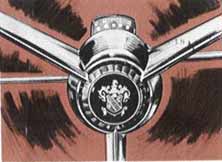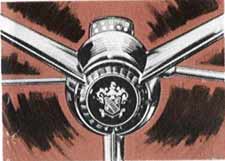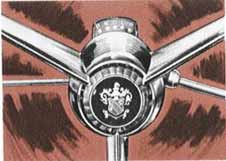| "D" This range is used for all normal forward driving. After the engine has been started, place Control Lever in "D" position and depress accelerator pedal. Nothing more need be done. The new converter with Variable Pitch Stator Blades enables the driver to select the efficient cruising position or the greater performance position by the normal operation of the accelerator pedal. An added resistance to the accelerator pedal operation is provided near the end of its travel. By fully depressing the pedal through this point the higher performance setting is achieved. |

|
|
"L" Maximum acceleration from a standing start is obtained by starting in "L" and shifting to "D" at 35 M.P.H.* The shift from "L" to "D" or vice versa may be made while the car is in forward motion by merely flipping the lever. These shifts should not be made at speeds over 40 M.P.H.
|
 |
| "R" This position reverses the car motion. To operate with car standing, raise and move control lever to stop at bottom of lever travel. Depress accelerator pedal for backing car. |
 |
Pushing or Towing Car to Start Engine - If it becomes necessary to push a Dynaflow Drive car to start the engine, place shift control lever in Neutral (N) until car speed reaches approximately 15 MPH, then shift into Low (L). Continue to increase car speed until engine cranks (approx. 25 MPH). After engine starts, return control lever to Neutral (N) for engine warm up. It is safer to push car than tow it.
*ECONOMY NOTE: When driving Dynaflow cars, Buick owners have a choice of good performance with economy or superb performance. Good fuel economy may be obtained by making normal starts and not attempting to obtain maximum acceleration at all times. If, however, you desire maximum performance on every start, you must expect less fuel economy.
FOR PERIODIC MAINTENANCE AND
LUBRICATION INSTRUCTIONS
SEE GENERAL MAINTENANCE SECTION